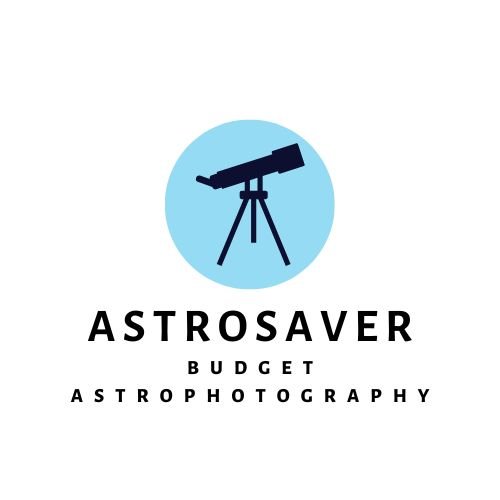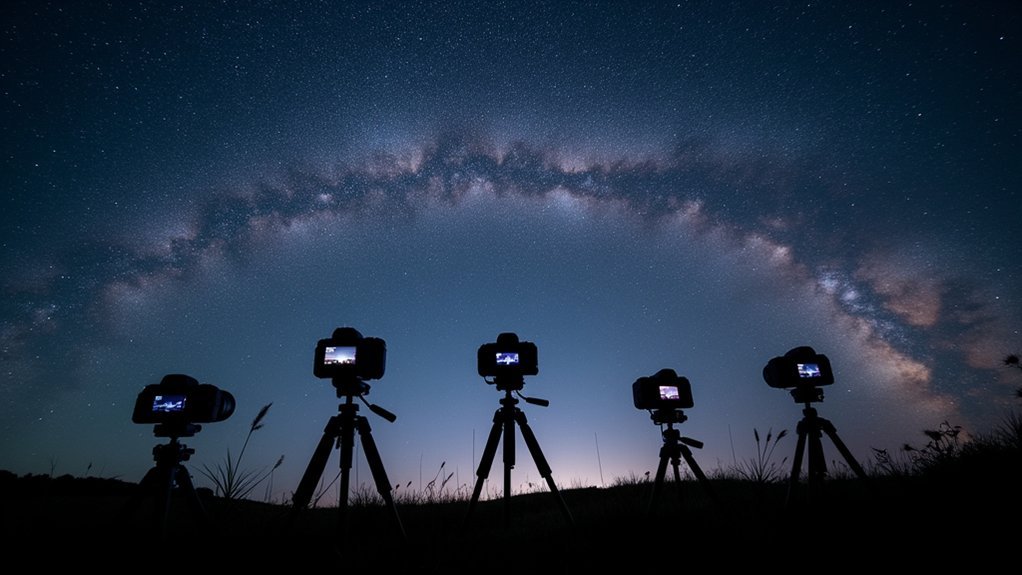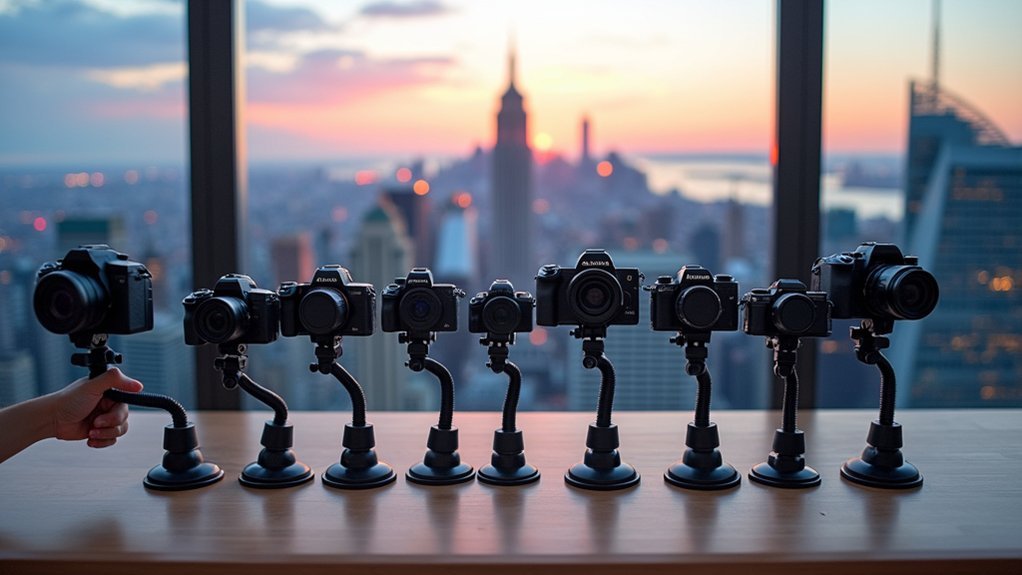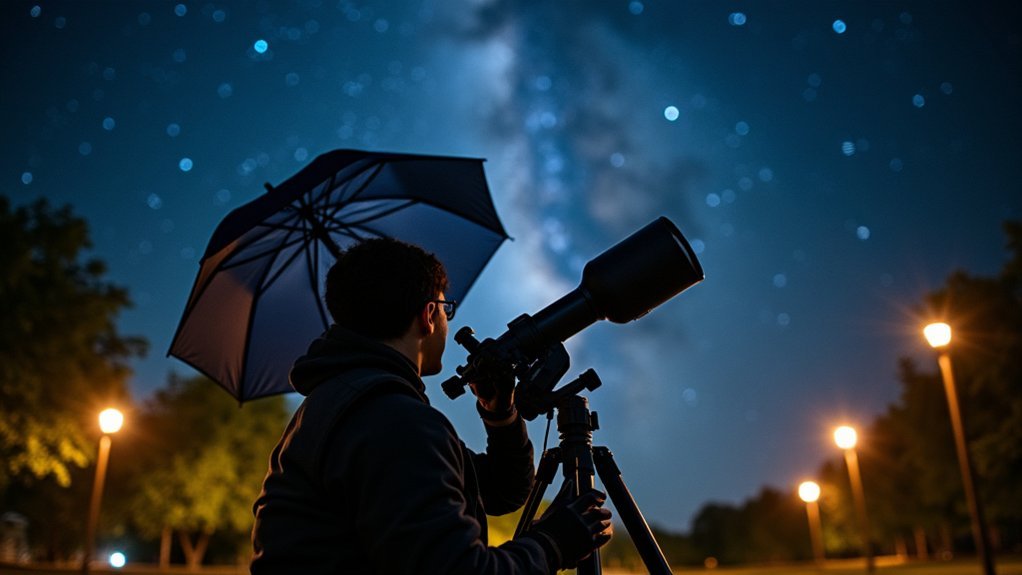You don’t need to empty your bank account to capture stunning images of the night sky. APS-C cameras have evolved dramatically, now offering capabilities that challenge their pricier full-frame counterparts for astrophotography. In 2025, several budget-friendly options deliver exceptional low-light performance, extended ISO ranges, and advanced focusing systems specifically beneficial for celestial photography. Let’s examine five remarkable cameras that prove you can photograph the cosmos without astronomical costs.
Canon EOS R100 Mirrorless Camera with RF-S18-45mm Lens Kit
Stargazers seeking an affordable entry into astrophotography will find the Canon EOS R100 Mirrorless Camera with RF-S18-45mm Lens Kit particularly appealing. This compact shooter packs a 24.1 Megapixel APS-C sensor with solid low-light performance ideal for capturing celestial objects.
The DIGIC 8 processor and RAW output capabilities give you flexibility when processing night sky images. While the kit lens isn’t optimized for astrophotography, you’ll benefit from the RF mount, allowing future upgrades to specialized lenses.
Despite limited manual ISO controls and inconsistent autofocus in dim conditions, you’ll appreciate its lightweight design during long night sessions.
Best For: Beginning astrophotographers who want an affordable, lightweight mirrorless camera with decent low-light capabilities and the flexibility to upgrade to specialized lenses in the future.
Pros:
- 24.1 Megapixel APS-C sensor delivers good image quality with RAW output for extensive post-processing of night sky photos
- Compact and lightweight design makes it comfortable to carry during extended nighttime shooting sessions
- Compatible with Canon’s RF mount system, allowing future upgrades to specialized astrophotography lenses
Cons:
- Kit lens (RF-S18-45mm) is not optimized for astrophotography and has limited light-gathering capability
- Manual ISO adjustments require navigating through menus, making quick setting changes difficult in the field
- Inconsistent autofocus performance in low-light conditions can be challenging for capturing celestial objects
Canon EOS Rebel T7 DSLR Camera with 18-55mm Lens
Budget-conscious astrophotographers will find the Canon EOS Rebel T7 DSLR an excellent entry point into night sky photography. Its 24.1 Megapixel APS-C sensor captures impressive detail in celestial objects, while the ISO range extending to 12800 helps with low-light performance.
You’ll appreciate the compatibility with Canon’s extensive EF lens lineup, allowing you to upgrade to specialized astrophotography lenses as your skills develop. The 9-point autofocus system with AI Servo assists in tracking moving celestial bodies.
The built-in Wi-Fi lets you transfer images wirelessly or even control the camera remotely during long exposure sessions.
Best For: Budget-conscious photography enthusiasts looking to explore astrophotography with an entry-level DSLR that offers room to grow through Canon’s extensive lens ecosystem.
Pros:
- 24.1 Megapixel APS-C sensor provides excellent detail capture for night sky photography
- Expandable ISO up to 12800 enhances low-light capabilities for astrophotography
- Built-in Wi-Fi enables remote camera control during long exposure sessions
Cons:
- Limited 9-point autofocus system may struggle with precise focusing on dim celestial objects
- No articulating screen makes awkward angle shooting (common in astrophotography) more challenging
- Video capabilities limited to Full HD rather than 4K, restricting time-lapse quality options
Canon EOS R50 Mirrorless Camera with RF-S18-45mm Lens Kit
Featuring a 24.2 Megapixel APS-C sensor paired with Canon’s powerful DIGIC X processor, the EOS R50 Mirrorless Camera kit stands out as an exceptional entry point for aspiring astrophotographers.
You’ll appreciate the exceptional low-light performance with Advanced A+ Assist when capturing night skies. The camera’s 651-zone Dual Pixel CMOS AF II system tracks celestial objects with precision, while 4K video capabilities let you create stunning time-lapses of star movements.
The lightweight, compact design makes it ideal for field work, and the vari-angle touchscreen simplifies composition during those awkward nighttime setups. Consider purchasing extra batteries for extended nighttime shooting sessions.
Best For: Beginners transitioning from smartphones to dedicated cameras who want high-quality photos and videos with user-friendly features, though not specifically optimized for astrophotography as suggested in the marketing text.
Pros:
- Excellent 24.2 Megapixel APS-C sensor with DIGIC X processor delivers high-quality images with vibrant colors and sharp details
- Versatile shooting capabilities with 4K video recording, high-speed continuous shooting up to 15 fps, and 651-zone Dual Pixel CMOS AF II system
- Compact, lightweight design with vari-angle touchscreen makes it ideal for vlogging and content creation with smartphone-like operability
Cons:
- Limited battery life likely requires purchasing additional batteries, especially for extended shooting sessions
- The included RF-S18-45mm F4.5-6.3 IS STM lens, while versatile, has a relatively slow maximum aperture that may limit low-light performance
- Despite marketing claims, this entry-level camera is not specifically designed for specialized photography like astrophotography without additional accessories and lenses
Factors to Consider When Choosing Budget-Friendly APS-C Cameras That Rival Full-Frame for Star Photography
When selecting an APS-C camera for astrophotography that competes with pricier full-frame models, you’ll need to prioritize exceptional low-light sensor performance and ISO noise handling capabilities. You should verify the camera’s lens compatibility range, ensuring access to wide-aperture lenses that capture more starlight with minimal distortion. Consider cameras offering extended shutter speed options and sufficient zoom capabilities that let you frame everything from wide-field Milky Way shots to detailed moon photographs.
Low-Light Sensor Performance
Although full-frame cameras traditionally dominate astrophotography discussions, today’s APS-C sensors deliver remarkable low-light capabilities at a fraction of the cost. You’ll find these sensors considerably outperform compact cameras by capturing more light, essential for revealing distant stars and nebulae.
Look for models offering ISO ranges of 6400 or higher—some even expand to 12800, letting you shoot in near darkness without excessive noise. Cameras equipped with DIGIC processors provide superior noise reduction at high ISOs, preserving detail while minimizing graininess.
Dual Pixel autofocus technology proves invaluable for night shooting, maintaining focus accuracy even in minimal light. For maximum quality, prioritize cameras with RAW output capabilities, giving you extensive control during post-processing to enhance star trails and celestial details.
Lens Compatibility Range
Beyond sensor capabilities, your lens selection dramatically impacts astrophotography results. When choosing an APS-C camera, consider the crop factor (typically 1.5x-1.6x), which affects your effective focal length and field of view. This makes wide-angle lenses essential for capturing expansive star fields.
Today’s APS-C systems offer impressive native lens ecosystems, with both zoom and prime options optimized for low light. Look for maximum apertures of f/2.8 or wider to gather more starlight. Most manufacturers provide quality glass at various price points.
Don’t overlook adapter options that let you mount full-frame lenses on your APS-C body, greatly expanding your creative possibilities. Third-party manufacturers like Sigma, Tamron, and Rokinon offer excellent budget-friendly alternatives that deliver impressive results for night sky photography without breaking the bank.
ISO Noise Handling
Despite their smaller sensor size, today’s budget APS-C cameras offer impressive ISO noise handling that can rival entry-level full-frame models for astrophotography. You’ll want to look for models with wide ISO ranges (ideally 100-6400 with expansion options to 12800 or beyond) to capture more light from distant stars without excessive graininess.
Modern APS-C cameras featuring advanced image processors can notably reduce noise at higher ISO settings. When selecting your camera, prioritize models with robust noise reduction technology and RAW shooting capability, as this format gives you greater flexibility to clean up noise during post-processing.
Remember that your lens choice works hand-in-hand with ISO performance. Pairing your APS-C camera with a lens offering a large maximum aperture will allow more light to reach the sensor, reducing your reliance on extremely high ISO settings.
Shutter Speed Options
Three critical shutter speed capabilities separate the best budget APS-C cameras from mediocre options for astrophotography. First, look for models with bulb mode and exposure times of at least 30 seconds without requiring additional equipment. This allows you to capture more starlight without investing in external intervalometers.
Second, prioritize cameras with effective electronic front-curtain shutters that minimize vibration during long exposures. Even slight camera shake can ruin star images at high magnification.
Finally, consider models with built-in intervalometer functions for creating star trails and time-lapses. The ability to program multiple long exposures automatically lets you capture dramatic celestial movements without constant manual intervention.
Remember to test your camera’s reciprocal rule performance—quality APS-C sensors should handle 20+ second exposures at 24mm without noticeable star trailing.
Zoom Capabilities Needed
The ideal zoom capability for astrophotography with budget APS-C cameras isn’t about reaching extreme magnifications, but rather finding versatile focal lengths that suit different celestial targets. While a combined 40x zoom range gives you flexibility, it’s the optical zoom that truly matters for maintaining image quality when capturing star details.
When selecting your camera, prioritize models compatible with quality telephoto lenses that don’t introduce digital noise. You’ll want the ability to switch between wide-angle shots for capturing expansive star fields and more focused telephoto capabilities for specific celestial objects.
Remember that superior low-light performance paired with good zoom functionality will greatly enhance your ability to focus clearly on stars, even in dim conditions. The right zoom lens turns your budget APS-C into a versatile astrophotography tool.
Autofocus Tracking Efficiency
Modern budget APS-C cameras often include autofocus capabilities that rival their full-frame counterparts when capturing the night sky. Look for models featuring Dual Pixel CMOS AF, which efficiently tracks stars and celestial objects during long exposure sessions.
You’ll want a camera with at least 651 autofocus points for ideal tracking precision. This allows you to maintain sharp focus on specific celestial bodies as they move across the frame. Many budget APS-C options now offer continuous shooting modes at several frames per second, increasing your chances of capturing perfectly focused astronomical events.
Don’t overlook low-light autofocus performance—it’s vital for star photography. Some newer models even adapt face and eye detection algorithms to track stars, eliminating the need for constant manual focus adjustments throughout your astrophotography session.
Image Stabilization Importance
Effective image stabilization stands as a cornerstone feature when selecting an APS-C camera for astrophotography, often making the difference between crisp star points and blurry smudges. When you’re capturing the night sky, even minor camera movements can ruin your long-exposure shots.
Look for models with robust in-body image stabilization (IBIS) or compatible lenses with optical stabilization. This technology allows you to use slower shutter speeds without introducing motion blur—critical when photographing faint celestial objects. You’ll appreciate the ability to maintain precise framing while capturing intricate star details.
The best part? Good stabilization works hand-in-hand with the camera’s ISO performance, letting you keep sensitivity levels lower for cleaner, noise-free images. This combination gives budget APS-C cameras surprising capability for stunning astrophotography results.
Battery Life Demands
When venturing into the domain of astrophotography, battery performance becomes your crucial lifeline, especially during those long nights tracking celestial objects. Most budget APS-C cameras offer between 300-800 shots per charge, but this rating drops considerably during extended exposures typical of star photography.
You’ll want to prioritize models with efficient processors that minimize power consumption despite higher megapixel counts. Don’t overlook the battery-draining impact of cold temperatures during night shoots—some cameras handle this challenge better than others.
Consider disabling Wi-Fi and wireless features when shooting to conserve power. For serious stargazing sessions, invest in multiple batteries and perhaps an external battery grip. Remember that the perfect shot often comes after hours of waiting, making reliable power management essential for capturing those magical celestial moments.
Frequently Asked Questions
How Does Sensor Cooling Affect Long-Exposure Astrophotography Shots?
Sensor cooling reduces noise in your long-exposure astrophotography shots. When you’re capturing faint celestial objects, cooler sensors produce cleaner images with better detail and less thermal noise, improving the overall quality of your night sky photos.
Can I Adapt Vintage Lenses for Astrophotography on These Cameras?
Yes, you can adapt vintage lenses for astrophotography. They’re often affordable and have excellent optical quality. You’ll need the right adapter for your camera’s mount, and manual focusing works perfectly for celestial objects.
Which Star-Tracking Mounts Work Best With Lightweight APS-C Cameras?
For lightweight APS-C cameras, you’ll get excellent results with the Sky-Watcher Star Adventurer, iOptron SkyGuider Pro, or Move Shoot Move tracker. They’re portable, affordable, and provide the precise tracking you need for stunning astrophotography.
How Much Dark Frame Subtraction Improves Astrophotography With These Cameras?
Dark frame subtraction dramatically improves your astrophotography by eliminating hot pixels and thermal noise. You’ll see cleaner images with better contrast, especially during long exposures. It’s essential when using APS-C cameras for night sky photography.
Are Internal Intervalometers Sufficient for Deep-Sky Imaging Sequences?
No, internal intervalometers aren’t sufficient for deep-sky imaging. You’ll need an external intervalometer or dedicated astrophotography software to handle longer exposures, dithering, and more complex sequencing for ideal results.





Leave a Reply